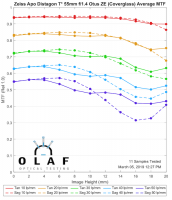How many of your DLSR lenses cost $3K and up? I tend to believe that the Zeiss Otus lenses offer excellent IQ, equal of better to lenses with short flange distances. But like Leica ASPH lenses, they aren't cheap. The evidence definitely supports that more expensive lenses can deliver better IQ. But shorter flange? Not so much.
A fair question and it is quite a complex subject. Much of the debate on this area is a bit like arguing whether a V8 supercar is "better" than a V12. There's no exact answer even if one limits the analysis to just one or two areas - and in reality cars like cameras are complex pieces of technology where there will be various criteria.
If I had to summaries it simply I would say that while the throat opening of a mount doesn't have a huge impact though a wider opening, inevitably, will offer some slight advantages to a lens designer if one is looking for peak corner performance with wide aperture lenses and are happy to see the camera be physically bigger. Leica's M mount as well as Sony's FE shows that one can have high quality glass with a tight throat. Of perhaps more interest is the flange distance. This is where the biggest difference tends to show. All else being equal (that's a big 'if") a shorter flange distance will allow higher quality and smaller wide angle lenses. And that's about it. The impact of this is diminished by the reality of modern digital sensors. With film the difference was more pronounced.
At the end of the day though, good lens design is good lens design. If one wishes for a fast aperture, good corner performance, autofocus, IS etc well the lens likely will be large.
Looking at Sony we see from their lenses as well as from third parties that for 24mm and wider lenses there appear to be advantages. I've often been critical of Sony, their quality control in particular is abysmal, but they have some excellent lens designers from Minolta and Nikon now. And lenses like the 16-35 GM, 24 GM, Laowa 15/2, Sony 12-24/4 - all of these are theoretically superior - both in quality and also compactness - to an SLR lens. The advantage disappears very quickly. The Sony 35mm 1.4 ZA, aside from being one of the most badly built lenses in terms of quality control, isn't much smaller than an SLR lens. By 50mm the advantage seems to have completely disappeared in terms of size though it perhaps still affords a lens designer some ability to create higher grade optics. Perhaps - it's hard to say. And beyond 50 the question is pointless.
It's also part of a package. Note I say those lenses are theoretically better. I would far rather trust a Canon lens to be working and serviceable in 10 years for example and also to be built properly however we must acknowledge that the Sony 16-35 GM is in certain respects, especially size, a superior design to the 16-35L III. And in terms of ergonomics I think that a lens like a 70-200 or a fast 300 or 400mm lens will almost always balance better on a mount like the EF one than the FE or even R. The centre of gravity will simply be in a different spot.
Long term I actually think Canon is serious about maintaining EF mount cameras, especially for longer lenses. I think they are smart, for example, to make the RF 70-200L be extending and thus much smaller. I've used an A9 with the 70-200GM - the tech is great but the handling is quite unbalanced and certainly it doesn't feel as good to hold as a 1DX or 5D model with the Canon 70-200L. And the size difference is negligible. Perhaps the clearest example is the Sony 24-70GM - it's actually bigger than the Canon 24-70L and is very unbalanced on the Sony cameras.
Looking back I think many people overhyped mirrorless when it came to size and quality. There was an assumption we would end up with Leica M size and quality lenses with autofocus at reasonable prices. That was aways fantasy. In many ways I think the company that has come out best from this is Leica - I find myself with newfound admiration for their ability to make such high quality but small lenses - however they are simply willing to compromise in other areas - notably autofocus and price - that Canon, Sony and Nikon never would or could.
The answer has to be to not worry and to concentrate on photography. There are clearly a handful of use cases where mirrorless might offer some advantages but I feel the differences between systems are still far greater. I have been tempted by the A7R III with Loxia lenses for landscape photography, especially the 21mm/2.8 which shows a clear advantage over the Zeiss equivalent SLR lens in both optical quality and size. But it would mean giving up so much else that I like from Canon that I am unwilling to go. In time I will buy an R mount camera with their wide angle zoom which will almost certainly be better than the current 16-35L III and I will probably then adapt over most of my EF mount glass as it should work perfectly. Hopefully Zeiss and Voigtlander will make some small manual focus options for the R mount and we will be set. There will not be a small and high quality 24-70/2.8L or 35/1.4L, at least not if one wants autofocus and to not pay Leica money. That's life.
So which is better - the V8 or V12? It's entirely a subjective decision - do you prefer Ferrari or Lamborghini? Do you prefer Canon or Sony?
Last edited:
Upvote
0

